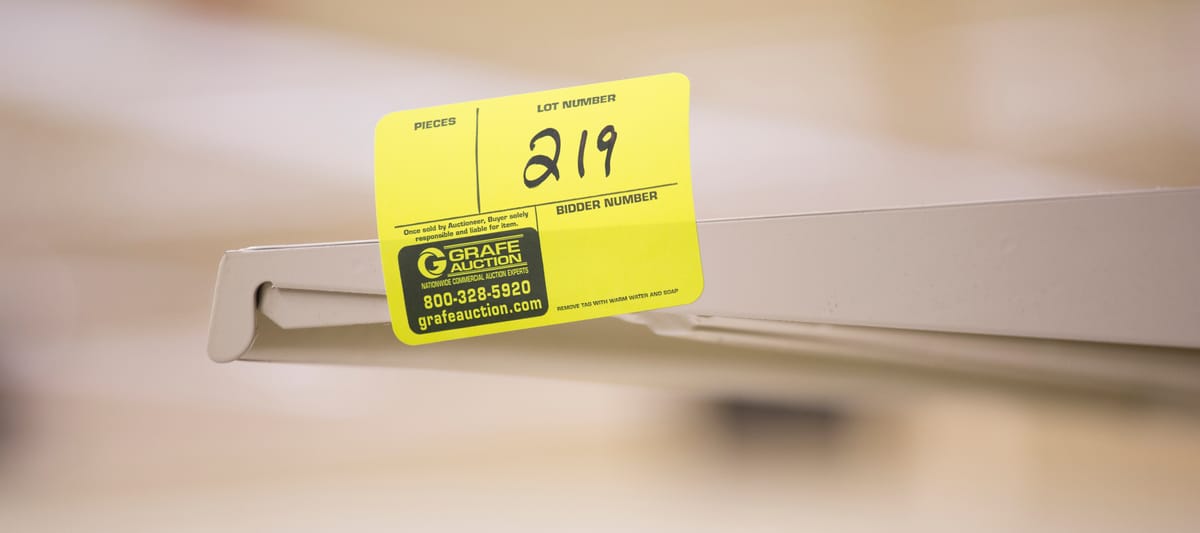Auction Insights: The Art of Cataloging

In the dynamic world of auctions, cataloging plays a crucial role in ensuring a smooth and successful process for both sellers and buyers. At Grafe Auction, we understand that a well-organized catalog not only tells the story of a business but also helps bidders make informed decisions. This blog offers insights into the art of cataloging, outlining key steps that contribute to a seamless auction experience.
The Walkthrough
To determine the scope of an auction, Grafe Auction staff work with sellers by conducting an initial walkthrough. In order to tell the story of your business, it's important that we first discuss the assets with you, and learn more about the business's history. It also gives us time to get a feel for the order in which the auction should be conducted, and learn about the condition that the assets are in.
The Cataloging Process
Grafe Auction has a dedicated team of logistics experts that travel the country to tag each item in a specific order so that it's best presented to bidders in an online auction. Because transparency is important to us, we host preview events typically the day before the auction. However, we understand that customers cannot always attend these events due to distance or timing, so cataloging is of utmost importance. Why? We want to make sure that the items are listed in a specific order that makes sense to both the seller and the bidder, and that the catalog conveys enough information for the bidder to make an informed buying decision.
For instance, many times an auction will have items that are very similar to one another. It doesn't make sense to have the lots for these items on the opposite ends of the auction. What if a bidder wants to purchase multiple lots of the same item? They shouldn't have to wait while other types of assets go by for that same one to come back around.

View Our Upcoming Auctions
Asset Popularity
What about importance or popularity of items? Grafe Auction has been conducting auctions since 1959, so we have the history and knowledge to know which items are typically going to be popular. Obviously, this changes over time, but we keep on top of trends and even use AI to predict the sale outcome of items. Many times, when our team is determining the order of auction items, we place the 'hot ticket' items near the front half of the auction. This helps buyers because, again, they're not wasting their time waiting hours for it to enter the ring. It also helps sellers get the most return on those items.
Capturing Auction Assets
Once the order is determined, our team gets to work on the next steps. They place those brightly-colored stickers on each lot, and then start taking photos for our website. The photos are such an important part in the auction process. They showcase the assets, detailing their condition (which is especially important for bidders who can't be there in person), and show any important information like brand, model number, and year, where possible. These photos are uploaded through an app that our team uses, directly to our website, saving time in the process. Within the app, the team also records the item's description and gives additional information if possible, such as the condition the item is in. That way, bidders can get the best possible viewpoint of the item before bidding.
Cataloging Best Practices
As detailed above, in an online auction, proper cataloging is essential for both transparency and efficiency. It ensures that bidders have all the information they need to make informed decisions, while also streamlining the auction process for sellers and buyers alike. In summary, if you are diving into cataloging yourself, the following best practices outline key steps to create a comprehensive and effective catalog:
- Logical Order
Organize items in a logical order that makes sense for both sellers and bidders. Group similar items together, such as all sheet pans in one section. This helps streamline the bidding process and allows bidders to efficiently focus on categories of interest without waiting for them to reappear. - Preview Events
While cataloging, schedule a preview event to give bidders a chance to inspect items in person. Ensure that the catalog is available online prior to the preview, so attendees can plan their visit. For bidders unable to attend, emphasize the importance of the catalog's accuracy to make up for the lack of in-person inspection. - Item Importance
Place "hot ticket" items near the front half of the auction, allowing bidders to see and bid on these high-value items early on. This reduces bidder waiting time and helps sellers get maximum returns. Additionally, keeping track of market trends and applying AI predictions can assist in identifying and placing key items effectively. - Real-time Adjustments
Be prepared to make real-time adjustments to the catalog as necessary, based on factors such as item conditions or seller preferences. This flexibility ensures that the auction process remains smooth and efficient for all parties involved.
Cataloging is a vital part of successful auctions, benefiting both sellers and buyers. It provides transparency, ensures efficiency, and enhances the overall auction experience. By following these best practices, auctions can reach their full potential, benefiting everyone involved.
Ready to take the next step? Contact Grafe Auction today to discuss how we can help catalog your assets, optimize your auction, and ensure a successful sale. Our experienced team is ready to guide you through every step, ensuring transparency, efficiency, and a seamless experience for all involved.

